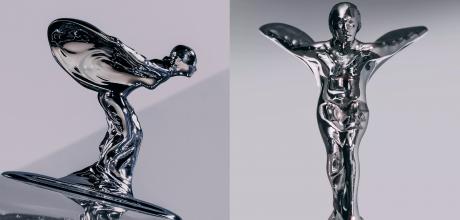Spirit of Ecstasy redesigned
Rolls-Royce has reimagined the Spirit of Ecstasy figurine for its new all-electric car, the Spectre, 111 years after the Spirit of Ecstasy was first registered as intellectual property of Rolls-Royce on 6th February 1911. The figurine has been remodelled with a lower, more dynamic stance that brings her much closer to the drawings made by her original creator, the illustrator and sculptor Charles Sykes, in the early years of the 20th century. She is somewhat more diminutive – 82.73mm versus 100.01mm, says Rolls-Royce with reassuring precision. Her robes, which flow behind her in the slipstream – often but erroneously characterised as ‘wings’ – have been subtly reshaped to make them more aerodynamic and realistic. The most visible change is her stance.
Previously, she has stood with her feet together, legs straight (except for the kneeling form available on various models between 1934 and the mid- 1950s) and tilting at the waist. Now, she is braced for the wind, one leg forward, body tucked low, her eyes focused eagerly ahead. These changes have both practical and stylistic benefits, says Rolls-Royce, and even contribute to the Spectre’s aerodynamic properties. The earliest Spectre prototypes have a drag coefficient (cd) of just 0.26, making it the most aerodynamic Rolls-Royce ever created. While all figurines are made using lost wax casting, each is individually finished by hand, so will be minutely different from figurine to figurine. This continues a long Rolls-Royce tradition – until 1939, the mascots were made and polished by Charles Sykes himself. The new version created for Spectre will appear on all future models: the current design will still be used on Phantom, Ghost, Wraith, Dawn and Cullinan and their Black Badge alter egos where applicable.
The new form is smaller, lower, sleeker and more aerodynamic, says Rolls-Royce.
The traditional lost-wax casting allows for fine detail to remain, even after plating


